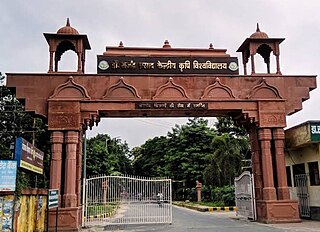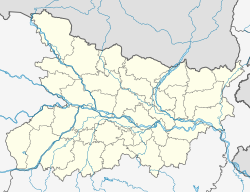
Darbhanga is the fifth largest city and municipal corporation in the state of Bihar in India, and is considered an important city in North Bihar. It serves as the headquarters of the Darbhanga district and the Darbhanga division. It is held that the name Darbhanga has been derived from Dwar Banga or Dari – Banga, meaning the 'door of Bengal'.

Vaishali district is a district of Mithila region in the Indian state of Bihar. It is a part of Tirhut division. Vaishali is known for being the birthplace of Mahavira of the Jain religion. Hajipur, its largest city and district headquarters, is known for its banana forest. The district is connected via the NH-77 and NH-322 highways, Gandhi Setu and Jay Prakash Setu Bridges over Holy Ganga River which connect the state capital Patna, the division headquarters Muzaffarpur, and the eastward district Samastipur.

Muzaffarpur is a city located in Muzaffarpur district in the Tirhut region of the Indian state of Bihar. It serves as the headquarters of the Tirhut division, the Muzaffarpur district and the Muzaffarpur Railway District. It is the fourth most populous city in Bihar.

Samastipur is a city and Municipal Corporation in Bihar, India. It is the headquarter of Samastipur district and comes under Darbhanga division. The Burhi Gandak River flows through the city. It is one of the five railway divisions of ECR, Hajipur. The Samastipur junction is one of the busiest station in North Bihar after Patna and Katihar.

Hajipur is the headquarters and largest city of Vaishali district of the state of Bihar in India. Hajipur is the 16th most populous city of Bihar, besides being the second-fastest developing city, next to Patna. It had a total population of 1.47 lakh as per census 2011. Vaishali district is ranked 8th among 38 districts in Bihar in terms of growth.

Samastipur is one of the thirty-eight districts of Bihar in India. The district headquarters are located at Samastipur. The district occupies an area of 2904 km² and has a population of 4,261,566.

Bakhtiyarpur is a town and a municipality notified area, near Patna City in Patna district in the state of Bihar, India. Bakhtiyarpur is under the Patna Sahib, and is a Vidhan Sabha constituency of Bihar in Patna District under the Barh sub-division of Bihar. It is a major railway junction in Danapur railway division, ECR. The incumbent Chief Minister of Bihar, Nitish Kumar belongs to Bakhtiyarpur.

Dalsinghsarai is a city and Municipal Council in the Samastipur District of Bihar, India. It is also one of the subdivisions and blocks of Bihar. It is situated on the bank of the river Balan.

Forbesganj is a city with municipality in the Araria District in the state of Bihar, India, situated at the border of Nepal.

Barauni is an industrial town situated on the bank of the river Ganges in the Begusarai district in the state of Bihar, India. It lies north of the Ganges (Ganga) River.
Digvijay Narain Singh was an Indian politician who served as a Member of Parliament. He started his career as a member of the Indian National Congress, later joining Morarji Desai's NCO faction in 1969, and then the Janata Party. He represented Pupri, Muzaffarpur, Hajipur, Vaishali et al. seats from Bihar in Lok Sabha from 1952 well into 1970s. He joined Janata Party in 1977 and was elected to Lok Sabha from Vaishali.

Mehsi is a CD Block and Mehsi Nagar Panchayat City and a municipality in the Purvi Champaran district in the Indian state of Bihar. It is a part of the Tirhut Division. The town is the entry point of the Purvi Champaran district. There are many smaller factories manufacturing buttons for the clothing Industry, although most of the population depends upon commercial business and Business agriculture.

Samastipur Vidhan Sabha (assembly) constituency is in Samastipur district in the Indian state of Bihar.

Morwa Assembly constituency is an assembly constituency in Samastipur district in the Indian state of Bihar.

North Bihar is a term used for the region of Bihar, India, which lies north of the Ganga river.

The Barauni–Gorakhpur, Raxaul and Jainagar lines are a set of three lines connecting Barauni in the Indian state of Bihar with Gorakhpur in Uttar Pradesh. The lines run in an east–west direction between the Ganges and India-Nepal border, covering northern Bihar west of the Kosi river and eastern Uttar Pradesh. The southernmost of the lines connects via Hajipur Junction, Sonpur Junction,Chhapra and Siwan Junction. The central line connects via Muzaffarpur, Motihari and Sugauli. The northern line connects via Darbhanga, Sitamarhi and Raxaul. The lines have interconnections between them and the northern line has extensions to places near the India–Nepal border.
The Muzaffarpur–Gorakhpur line is a set of three lines connecting Muzaffarpur in the Indian state of Bihar with Gorakhpur in Uttar Pradesh. The lines run in an east–west direction between the Gandak and India–Nepal border, covering North Bihar west of the Kosi river and eastern Uttar Pradesh. The southernmost of the three lines connects via Hajipur Junction, Sonpur Junction and Chhapra. The central line connects via Motihari and Sugauli. The northern line connects via Sitamarhi and Raxaul. The lines have interconnections between them and the northern line has extensions to places near the India–Nepal border.

Devesh Chandra Thakur is an Indian politician from the Janata Dal United, and a Member of Parliament representing Sitamarhi(Lok Sabha constituency) in Bihar, India. He is a former chairman of the Bihar Legislative Council and has served as a Cabinet Minister of Disaster Management Department in the Government of Bihar.
Raghopur Narsanda is a village in the Vaishali district of Bihar, India, in Patepur Block. It is 60 km from the main local city of Patna, and 40 km from its district headquarters of Hajipur. Its nearest towns are Muzaffarpur Patepur, Chehrakala, Jandaha, Samastipur Mahnar, Garaul and Tajpur.
Sagauli Junction railway station is a junction railway station in East Champaran district, Bihar. Its code is SGL. It is on the Delhi–Muzaffarpur–Gorakhpur main line















